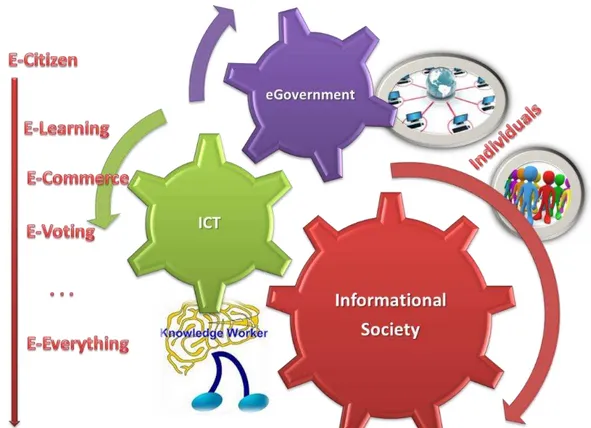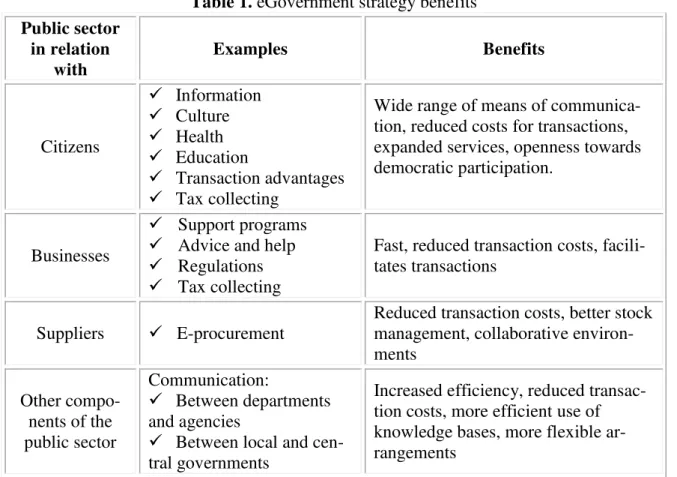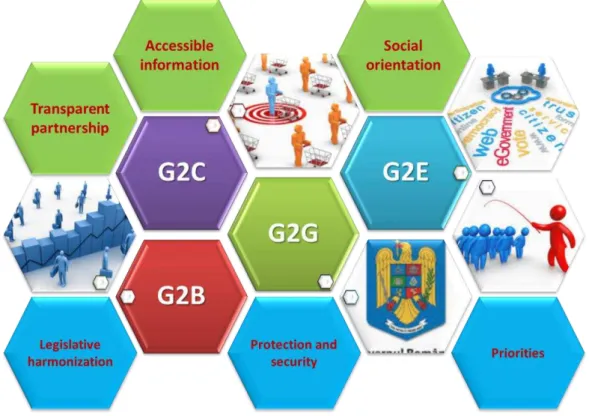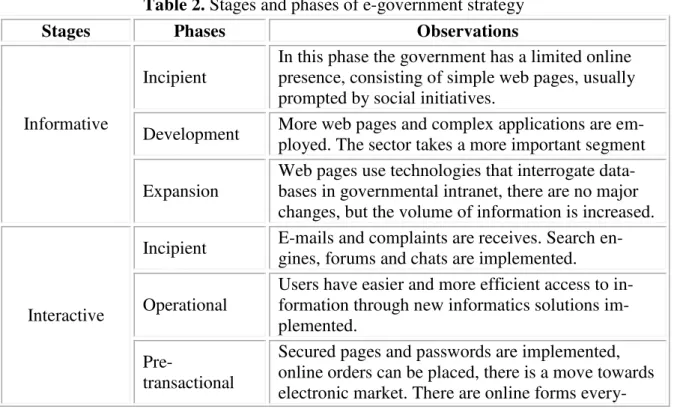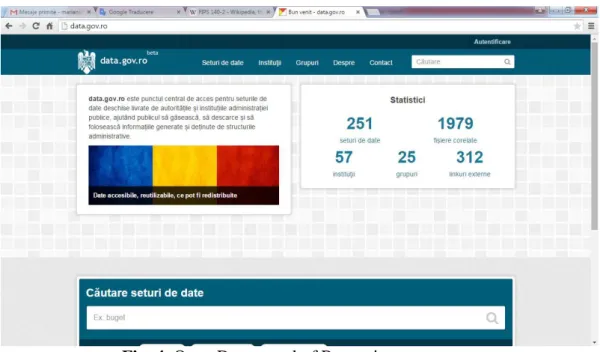Challenges of 4D(ata) Model for Electronic Government
Bogdan GHILIC-MICU, Marian STOICA, Cristian USCATU Bucharest University of Economics, Romania
ghilic@ase.ro, marians@ase.ro, cristiu@ase.ro
Social evolution pyramid, built on the foundation of the ‘90s capitalist society, lead to the
emergence of the informational society – years 1990 to 2005 – and knowledge society – years 2005 to 2020. The literature starts using a new concept, a new form of association – artificial intelligence society – foreseen to be established in the next time frame. All these developments of human society and translations or leaps (most of the times apparently timeless) were, are and will be possible only due to the advancing information and communications technologies. The leap to Democracy 3.0, based on information and communication technologies prompts to a radical change in the majority of the classical concepts targeting society structure and the way it is guided and controlled. Thus, concepts become electronic concepts (or e-concepts) through the use of new technologies. E-concepts keep the essence of the classical principles of liberty and democracy, adding a major aspect of the new way of communication and spreading ideas between people. The main problem is to quantify, analyze and foresee the way technological changes will influence not only the economic system, but also the daily life of the individual and the society. Unfortunately (or maybe fortunately, depending on the point of view), all these evolutions and technological and social developments are as many lenges for the governments of the world. In this paper we will highlight only four of the chal-lenges facing the governments, grouped in a structured model with the following specific con-cepts: Big Data, Social Data, Linked Data and Mobile Data. This is an emerging paradigm of the information and communication technology supporting national and global eGovernment projects.
Keywords: Democracy 3.0, Big Data, Social Data, Linked Data, Mobile Data, eGovernment, Information and Communication Technology (ICT)
Introduction
An essential component of informational society is e-democracy, which concerns the activity and interactions of citizens, pub-lic institutions and political organizations through information and communications technology (ICT). The purpose of these ac-tivities is the development and promotion of democracy values through citizens’ particip a-tion to the decisional process together with the public authorities, so that citizens can re-ally see the results of their efforts. ICT facili-ties, especially communication environments used for interaction by citizens, organizations and public institutions become fundamental instruments in the process of modernization of society and government structures.
While electronic government mainly refers to accessibility of government services, elec-tronic democracy refers to the citizen’s active role in enlarging his possibilities through
ICT. Thus, electronic democracy allows citi-zens to get involved in public institutions’ a c-tivity, taking part in the decisional process, and it allows the government to react ade-quately to citizens’ needs [1].
Thus, in the last decade, the governments of the most developed economies have started a move towards e-government in order to im-prove services not only for citizens, but also for the business environment, promoting the social and economic development. E-government also means online interactions between government agencies, and govern-ment and employees, not only interactions between government and citizens. These in-teractions take place through online plat-forms, including mobile applications (m-government).
Information society impact on personal life and individual development of citizens may
be analyzed from several points of view. Such an analysis must consider firstly the model of this new type of society with all its political, economic and social characteristics both on the level of individual countries and on international level.
This new concept implemented on country
level helps users and has multiple benefic ef-fects. Informational society relies heavily on large scale use of ICT at work, in relation with authorities and public institutions and everyday life (for shopping, instruction, and various other activities – Figure 1).
Fig. 1. Informational society and its relation with individuals
In the last years numerous analyses were car-ried out regarding public sector and its rela-tions with society. Because of increased de-mand for public services, budget restrictions and high personnel costs, but also due to the help of new ICT features, the concept of electronic government or eGovernment was born and propagated.
2 Electronic Government
The literature provides many expressions and definitions related to electronic government concept. Still, there are some common ele-ments that lead to a generally accepted defi-nition. Thus, in a European approach, elec-tronic government is defined as the use ICT in public administration, along with organi-zational changes and acquiring new compe-tencies, in order to improve public services
and democratic processes [2].
The concept itself refers, in principle, to the interactions between state public institutions and the citizens through electronic means. These interactions are not limited only to ac-cessing information regarding current proce-dures or regulations. Electronic government also means more sensible elements like digi-tal signature, electronic payment, electronic vote, laws and regulations, public procure-ment and electronic auctions, affidavits, li-censes and approvals etc.
infor-mation, its quality transparency, promoting to the proper users. The slow increase of eGovernment popularity compared to other online services lead the users to distrust online public services, creating a vicious cir-cle.
Electronic democracy (e-government) mani-festations go beyond the democratic process. No vision of informational society govern-ment would be complete without taking into account the digital democracy. The range of
e-democracy covers, mainly, recording of poll participants, the poll act, consulting the public opinion, communication between elected persons and their constituents, en-couraging people to take part into the legisla-tive process etc. Live hearings, online expert consultation, public opinion consultation as well as open communication and information create opportunities for real time participa-tion in the act of governing.
Table 1. eGovernment strategy benefits Public sector
in relation with
Examples Benefits
Citizens
Information Culture Health Education
Transaction advantages Tax collecting
Wide range of means of communica-tion, reduced costs for transactions, expanded services, openness towards democratic participation.
Businesses
Support programs Advice and help Regulations Tax collecting
Fast, reduced transaction costs, facili-tates transactions
Suppliers E-procurement
Reduced transaction costs, better stock management, collaborative environ-ments
Other compo-nents of the public sector
Communication:
Between departments and agencies
Between local and cen-tral governments
Increased efficiency, reduced transac-tion costs, more efficient use of knowledge bases, more flexible ar-rangements
Electronic government is an instrument that contributes to the harmonization of relations between citizens and public authorities, based on mutual respect and interested col-laboration between the state and citizens. Both theoreticians and practitioners identify and recognize (by use in specific projects) the four pylons of electronic government: G2C (government to citizen/consumer), G2B (government to business), G2G (government to government / administration), G2E (gov-ernment to public employees). All these forms are based on electronic government principles, synthesized in six
recommenda-tions (Figure 2):
A. Transparent partnership – all activities must be transparent, publicly discussed, con-sidering the opinions and ideas of all parties involved;
B. Accessible information – respect the cit-izens fundamental right of access to public information;
C. Social orientation – implement electron-ic government considering the citizens’ needs;
E. Protection and security – respect the constitutional rights and liberties of citizens in the process of creating, storing, processing and transmitting information, including pro-tection of personal data, through means and
methods of ensuring information security; F. Priority for political, economic and so-cial dimension against the technological as-pects.
Fig. 2. Principles of electronic government
Electronic government provides administra-tions with an online environment for provid-ing information, observprovid-ing the most im-portant concepts of electronic environment [3]. Also, the 4D(ata) approach highlights the benefits of applying Linked Data and Big Data concepts. The accent is on accountabil-ity of governments regarding public data. Al-so, Social Data concept evaluates the social dimension of electronic government.
3 Big Data Dimension of 4D(ata) Model A multitude of references in literature puts Big Data either in the category of abstract concepts or specific instruments of infor-mation and communications technology. For comprehensiveness, our approach will con-sider both aspects. Thus, we may define Big Data as the concept used to describe datasets of such large size and high complexity that prevents standard applications to process them. The size of these datasets is above the
contrary, Big Data may help lots of govern-ments in serving their citizens, overcoming the national problems and challenges like un-employment and fraud fight (for example the American program Medical Fraud Strike Force – http://www.stopmedicarefraud.gov). On European side, the first government to employ Big Data was Great Britain, through Horizon Scanning Center. Using this project, the British government tried to find answers to the problem of global warming, regional and international tensions and security. The project with the most significant impact on electronic government was launched in 2009 through the public portal www.data.gov.uk. It provides users, since the first year of launch, with thousands of datasets to help them understand the governing ways and pol-icies. The platform offers the citizens the possibility to get involved in electronic gov-ernment, giving them the e-citizen statute [5].
4. Social Data Dimension of the 4D(ata) Model
There are multiple possibilities to define So-cial Media. Most definitions highlight three important elements: (1) user generated con-tent, (2) communities and (3) Web 2.0. [6] Globalwebindex, for example, quoted by [7],
provides the statistics regarding the use of
Social Media
(http://www.globalwebindex.net). First four platforms on top are Facebook, Google+, Youtube and Twitter. The next three plat-forms are social networks from China, in-cluding Sina Weibo, Tencent, Weibo and Qzone.
In the context of the proposed 4D(ata) para-digm, Social Data means the structured in-formation obtained from analyses and statis-tics that describes the behavior patterns of individuals regarding certain public interest subjects. The information is drawn from the use of electronic platforms, mainly social platforms and web services that favor human interaction. This information is gathered on a specific time frame and used to extrapolate certain behavior patterns or collective trends of change (in specific domains of interests: culture, sport, education, entertainment, fash-ion etc.).
The perspective of electronic government must perceive Social Data in terms of data voluntarily created and disseminated by citi-zens through social platforms. This type of data is mainly subjective and they must be considered appropriately in e-government strategies (Table 2).
Table 2. Stages and phases of e-government strategy
Stages Phases Observations
Informative
Incipient
In this phase the government has a limited online presence, consisting of simple web pages, usually prompted by social initiatives.
Development More web pages and complex applications are em-ployed. The sector takes a more important segment
Expansion
Web pages use technologies that interrogate data-bases in governmental intranet, there are no major changes, but the volume of information is increased.
Interactive
Incipient E-mails and complaints are receives. Search en-gines, forums and chats are implemented.
Operational
Users have easier and more efficient access to in-formation through new informatics solutions im-plemented.
Pre-transactional
every-Stages Phases Observations where.
Transactional
Pilot Authentication methods are tested. Gradually move towards providing government services on internet.
Intermediary
Population starts to use transactional characteristics of web sites, but in small numbers. This is the first measurable reaction of citizens.
Full use
Electronic services and new communication chan-nels are accessed by large numbers of citizens. Peo-ple now know how to efficiently use e-government.
Integrative Implementation
There is a large similarity in the ways services are provided on the web (user friendly interfaces, secure links), hence portals appear.
Social Data dimension is used by the gov-ernment to understand the public opinion, an-ticipate the reaction to adoption of govern-mental decision.
5 Linked Data Dimension of 4D(ata) Model
The term of Linked Data (interconnected da-ta) was introduced by Sir Tim Berners-Lee, director of World Wide Web (W3C) consor-tium and creator of World Wide Web (in 1990), in one of his works on the architecture of web space [1], [8]. The term describes a way of publishing and interconnecting data in a structured form, starting from the idea that data becomes more valuable and more credible when they are connected to other da-ta. This model seeks to standardize data from heterogeneous sources, using as main rules the RDF model (Resource Description Framework) in order to publish structured data on the web.
As dimension of 4D(ata) paradigm in relation with electronic government, Linked Data de-scribes a way to publish structured data so that they interconnect and increase their usa-bility through semantic queries. This data may be built on current standards, like HTTP, RDS or URI (Uniform Resource Identifier), with the goal of enriching compu-ting units data bases, leading to more
rele-vant results.
There are numerous benefits for governments using linked data standards to publish data. Lots of governments have started a decade ago to create a governmental linked data web space inside an interconnected data cloud. These attempts involve a more responsible and secure availability of data and for con-sumers this translates into easier and more flexible access to government data.
In the last years there are more and more government projects involving the use of Linked Data. Starting with www.data.gov platform of United States (figure 3) and con-tinuing with European Union LATC (Linked open data Arround The Clock), PlanetData project, DaPaaS (Data and Platform as a Ser-vice) project and Linked pen Data 2 (LOD2) project, they all provide thousands of datasets for every user.
Fig. 3. Open Data portal of United States government
One example of Linked Data for geo-spatial information is provided by the British gov-ernment. Through the INSPIRE directive, Great Britain makes sure the European coun-tries exchange spatial information. Among other functionalities, the directive provides identifiers for spatial objects and a resolution mechanism (built on standard web architec-ture).
The equivalent of this British initiative in Romania is http://data.gov.ro (still in beta version for now – see Figure 4), that follows a similar model. Through the 2013-2016 Government Program, with the support of Department of design and Online Service, citizens are empowered to “identify, dow n-load and use data sets the are public or owned by public administration” [4].
Fig. 4. Open Data portal of Romania government
The Romanian portal provides citizens with 251 data sets from various sources: Ministry
Anticorruption Department (DGA) also pro-vides nine reports, some of them targeting the evaluation and implementation of some laws, “Centralized report on DGA personnel travels in 2013”, and other general interest information. Not all institutions provide in-formation, not all information is complete and up to date, but data.gov.ro promises to facilitate access to all public government da-ta, in an unified manner.
6 Mobile Data Dimension of 4D(ata) Model
Like the other three dimensions of the 4D(ata) paradigm related to electronic gov-ernment, Mobile Data is a natural conse-quence of technological development. The mobile phone has evolved from a simple voice device to multimedia communications, able to access and transfer audio and video data, functioning also as a global positioning device, electronic wallet etc. In this context, government applications may take advantage of the functionalities of this widely used de-vice.
Correlated with the terms previously ana-lyzed, Mobile Data means the possibility to provide citizens with a collection of instru-ments for strategic use of governmental ser-vices or applications available only for mo-bile devices, laptops, tablets and wireless in-ternet infrastructure.
The relation between citizens and the gov-ernment has changed since the apparition of Open Data concept and mobile applications. They now interact through application for public transportation payment through mo-bile phone, emergency applications etc. on the background of a trend to provide more transparent public data. In a continuously changing society, adapting to more flexible economic and political conditions, the changes do not stop here (see the concept of
democracy 3.0).
For example, in USA, government agencies have developed applications for airport secu-rity (MyTSA – Transportation Security Ad-ministration) or applications that help small enterprises to apply for various regulations. Other applications provide instructions for
emergency situations, maps to shelters and rescue centers. Still, the potential of mobile data is only exploited by governments on a small scale.
The possibilities are vast, for example: Na-tional Agency for Environment Protection might develop applications for monitoring fires and natural disasters. In order to help the development of this area, the government must collaborate with the business and aca-demic environments, for mobile and web ap-plications to provide through clouds general interest data, open and available to solve real problems. Due to the increased number of mobile devices in use (each with internet connection, GPS features, development ap-plications), governments must look into the security of mobile data. In USA, for exam-ple, security requirements for the mobile en-vironment are established in the FIPS 140-2 standard (the Federal Information Processing Standard), that certifies cryptographic mod-ules, protecting inactive data (data at rest) and active data (data in use) for public sector (four levels of security).
In this context, the move to mGovernment is still a challenge for governments, which must choose from multiple possibilities and tech-nical solutions. Although required resources are available, after planning, development and testing there is the problem of launching, acceptance from citizens, maintenance and security.
7 Conclusions
ex-ample the governmental portal for public procurement SEAP – www.e-licitatie.ro). The concepts of Big Data, Social Data, or Mobile Data may be successfully integrated in order to increase the efficiency of activi-ties in multiple governmental segments. This can lead to significant benefits for the state, like increased trust, and for the citizens, by improving the interactions with government institutions.
While the implementation of electronic gov-ernment was an important decision, adopted by most governments of the world, mobile technologies had a fast advancement and de-velopment, making the use of mobile tech-nologies for providing services and infor-mation a requirement rather than an option. Since there is a continued demand for mobili-ty and public sector efficiency and productiv-ity increases by using mobile technologies, we foresee a move from eGovernment to mGovernment. Thus, mobile government is the next step in the process of using infor-mation and communications technology for public sector.
Acknowledgement
A shorter version of this paper was presented at the 14th International Conference on Informatics in Economy (IE 2015), May 1-3, 2015.
References
[1]W3C. Internet:
http://www.w3.org/standards/semanticwe b/data, 2013, [Feb. 20, 2015].
[2] Roșca I. Gh., Ghilic-Micu B., Stoica M. –
coord., Informatica. Societatea
Informațională. E-Serviciile,Economica Publishing House, 2006.
[3]Programul de guvernare 2013-2016. In-ternet: http://data.gov.ro/about, [Feb. 20, 2015].
[4]European eGovernment Action Plan
2011-2015. Internet:
http://ec.europa.eu/digital- agenda/en/european-egovernment-action-plan-2011-2015, Digital agenda for Eu-rope, A Europa 2020 Initiative, [Feb. 20, 2015].
[5]Internet: http://data.gov.uk/faq, [Feb. 20, 2015].
[6]T. Ahlqvist, A. Bäck, M. Halonen and S. Heinonen (2008), Social Media Roadmaps. Exploring the futures trig-gered by social media, [On-line]. VTT Technical Research Centre of Finland, ESPOO 2008, VTT TIEDOTTEITA re-search notes 2454 ISBN
978-951-38-7247-2, Available:
http://www.vtt.fi/publications/index.jsp [Feb. 20, 2015].
[7]M. Hu and L. Bing, “Mining and Summa-rizing Customer Reviews”, in Proceed-ings of ACM Conference on Knowledge Discovery and Data Mining (ACM- SIGKDD-2004), Seattle, Washington, 2004.
[8]Epimorphics Ltd. Internet: http://www.epimorphics.com/web/resourc es/what-is-linked-data, 2012, [Feb. 20, 2015].
Marian STOICA received his degree on Informatics in Economy from the Bucharest University of Economic Studies in 1997 and his doctoral degree in economics in 2002. Since 1998 he is teaching in Bucharest University of Economic Studies, at Informatics and Cybernetics Economy Department. His research activity, started in 1996 and includes many themes, focused on management information systems, computer programming and information society. The main domains of research activity are Information Society, E-Activities, Tele-Working, and Computer Science. The finality of research activity still today is represented by over 80 articles published, 25 books and over 40 scientific papers presented at national and international conferences. Since 1998, he is member of the research teams in over 30 research contracts with Romanian National Education Ministry and project manager in 5 national research projects.
Cristian Răzvan USCATU received his degree on Informatics in Economy
